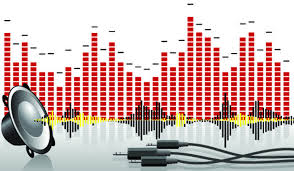There are two kinds of audio compression, and they’re not the same. But people get them confused all the time, and it’s driving me nuts.
Imagine you’re holding a sponge.Now squash it in your fist.
When you squash the sponge, it takes up less space. The more you squash it, the less like a sponge it looks. But when you release it it springs back again, unharmed.
You can do the same thing to audio – that’s audio compression. Good old-fashioned audio compression, as has been widely used in pop music since the 60s at least – The Beatles started using it on Paul’s bass around the time of “Paperback Writer” and from then onwards, for example.
Using a compressor on audio does the same thing as your fist does to the sponge – it squashes it into a smaller space, so it can be packed more densely. When you record a compressed audio signal it’s like taking a photograph of the squashed sponge – the results become “locked in”. If you squash it so much that it doesn’t “look like a sponge” any more and then record it, you’ve dramatically changed the sound of the original audio.
This is known as ‘dynamic range compression'[DRC], and it’s used to control very lively sounds (like the human voice, or a bass guitar) to reduce contrast – originally to make the most of the limited “headroom” on radio and vinyl, and often as a creative effect.
In the past this was all done with analogue electronics – valves and transistors – but nowadays you can get digital audio compressors that do the same thing. Musicians and sound engineers argue about whether digital compressors sound as good as analogue compressors, but they do the same job.
If you overdo compression, it often sounds bad – and modern digital compressors have enabled people to take that to a whole new level. But that’s a whole other discussion…
Back to the sponges
Now get your sponge, and cut it up with scissors.
It no longer looks like sponge, right ?
BUT (and this is where the sponge analogy breaks down a little, I admit) if you had some magic “sponge glue”, you could re-assemble the sponge to it’s original self again, if you were careful about how you labelled the pieces in the first place.
Now of course there’s no such thing as “magic sponge glue” in the real world – that would just be silly (!) – but in the digital world of computers, there absolutely is.
Once the sponge (or the music, are you still with me ?) is recorded as digital information, it can be chopped up, re-packed into half the original size, sent halfway round the world and re-assembled again – perfectly. No magic sponge glue is required – the reconstructed digital sponge is identical to the original digital sponge.
This what happens when you make a zip file of something before you email it.
It’s called lossless data compression – “compression” because the original digital items data is re-packed into a smaller space, and “lossless” because nothing gets damaged along the way – but it’s an entirely digital process, and it’s nothing like dynamic range compression (sponge squashing) at all – either the analogue or the digital variety.
Here’s where it gets really messy for the sponge
NOW imagine that instead of cutting the sponge up with scissors, you gouge it’s heart out.
(Relax, sponge-fans, this is just a thought experiment ! No sponges were harmed during the writing of this post.)
Seriously – cut a small hole in the sponge and pick all the insides out, until you’re left with only a thin outer shell. If you’re careful, you’ll end up with something that still looks like the original sponge. It’s had it’s heart ripped out, true – but it still looks OK.
The digital equivalent of this process is also known as data-compression – but it’s different to the “chop-up-and-reassemble” variety, because at the end of the process, 90% of the original sponge is missing.
This is what happens when you make a jpeg or mp3 file, and it’s called lossy data compression. “Compression” because again, it’s been squashed into a (much) smaller space, and “lossy” because something has been lost – the 90%.
It’s important to notice that the process is permanent – once the heart of the sponge is thrown away, you can’t put it back. So, you need to be careful which bits of the sponge you pick out, and not to take too much away. In the same way, it’s vital to make a good job of using lossy compression on your audio when encoding an mp3 file.
The chances are though, looking at the digital sponge after lossy compression, you won’t spot the difference – in the same way that many people don’t notice the quality lost in an mp3 encode.
What does all this have to do with Neil Young, Bob from St Etienne and the PM show ?
Both over-squashing a musical sponge, and gouging the heart out of it, damage the sponge.
In the same way, both over-compressing music when recording it, and mp3 encoding it, can spoil the music.
And both of these happen all the time, at the moment – music is hugely over-compressed in futile attempts to win the so-called Loudness War – and most people listen to music that has been through lossy compression almost exclusively.
Digital TV uses lossy data-compression, digital radio uses it, mp3 files use it, the iTunes store uses it, Spotify uses it…
So, both the compression have made listening to music more easy and better upto a certain extent, but over-compression is taking the life out of the music, and the sponge.





8 Comments. Leave new
Nice article
Very Well explained! The example used to explain the concept is commendable. 🙂
Nice analogy! Very informative.
informative!!
Nicely written
You have used good examples and successfully made an intense topic a fun to read. This is what I like in an article. Very well written.
Well explained!
Nice one, very informative too